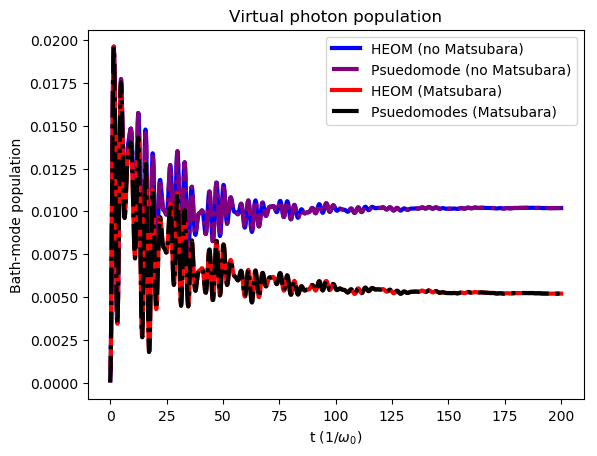Virtual photon population¶
In the ultrastrong coupling regime (defined as where the qubit-environment coupling is on the order of the bath frequencies), the combined system-environment “groundstate” contains a finite population of photons (and matter excitations) which in principle cannot be observed. The Matsubara terms are crucial to both calculated the correct properties of this ¨groundstate¨, and make sure that the virtual excitations are trapped in that ground state.
In case of the pseudomode we calculate the expectation value of the non-Matsubara mode bath operators. For the HEOM method, the Auxiliary Density Operators (ADOs) of the evolution contain information about the bath operators [ZLXS12], [SS17] as shown in Eq (18) of [LACN19]. Here we show how to extract them from the full HEOM evolution.
import numpy as np
from matsubara.correlation import (nonmatsubara_exponents,
matsubara_zero_analytical,
biexp_fit, sum_of_exponentials)
from qutip.operators import sigmaz, sigmax
from qutip import (basis, expect, tensor, qeye, destroy, mesolve,
spre, spost, liouvillian)
from qutip.solver import Options, Result, Stats
from matsubara.heom import HeomUB, get_aux_matrices
import matplotlib.pyplot as plt
# Extract virtual photon population from HEOM
wq = 1.
delta = 0.
coup_strength, bath_broad, bath_freq = 0.2, 0.05, 1.
Q = sigmax()
tlist = np.linspace(0, 200, 1000)
Nc = 9
Hsys = 0.5 * wq * sigmaz() + 0.5 * delta * sigmax()
initial_ket = basis(2, 1)
rho0 = initial_ket*initial_ket.dag()
omega = np.sqrt(bath_freq**2 - (bath_broad/2.)**2)
options = Options(nsteps=1500, store_states=True, atol=1e-12, rtol=1e-12)
# zero temperature case, renormalized coupling strength
beta = np.inf
lam_renorm = coup_strength**2/(2*(omega))
ck1, vk1 = nonmatsubara_exponents(coup_strength, bath_broad, bath_freq, beta)
# Ignore Matsubara
hsolver_no_matsubara = HeomUB(Hsys, Q, lam_renorm, ck1, -vk1, ncut=Nc)
output_no_matsubara = hsolver_no_matsubara.solve(rho0, tlist, options)
# Add zero temperature Matsubara coefficients
mats_data_zero = matsubara_zero_analytical(coup_strength, bath_broad, bath_freq,
tlist)
ck20, vk20 = biexp_fit(tlist, mats_data_zero)
hsolver_matsubara = HeomUB(Hsys, Q, lam_renorm, np.concatenate([ck1, ck20]),
np.concatenate([-vk1, -vk20]), ncut=Nc)
output = hsolver_matsubara.solve(rho0, tlist, options)
# Get the auxiliary density matrices from the full Hierarchy ADOs
aux_2_list, indices1 = get_aux_matrices(hsolver_no_matsubara.full_hierarchy, 2, Nc, 2)
aux_2_list_matsubara, indices2 = get_aux_matrices(hsolver_matsubara.full_hierarchy, 2, Nc, 4)
virtual_photon_heom_no_matsubara = np.array([aux.tr() for aux in aux_2_list[1]])
virtual_photon_heom_matsubara = np.array([aux.tr() for aux in aux_2_list_matsubara[8]])
# =======================================
# Compute the population from pseudomode
# =======================================
print("pseudomode")
lam2 = np.sqrt(lam_renorm)
Ncav = 4
# Construct the pseudomode operators with one extra underdamped pseudomode
sx = tensor(sigmax(), qeye(Ncav))
sm = tensor(destroy(2).dag(), qeye(Ncav))
sz = tensor(sigmaz(), qeye(Ncav))
a = tensor(qeye(2), destroy (Ncav))
Hsys = 0.5*wq*sz + 0.5*delta*sx + omega*a.dag()*a + lam2*sx*(a + a.dag())
initial_ket = basis(2, 1)
psi0=tensor(initial_ket, basis(Ncav, 0))
options = Options(nsteps=1500, store_states=True, atol=1e-13, rtol=1e-13)
c_ops = [np.sqrt(bath_broad)*a]
e_ops = [sz, sm.dag(), a, a.dag(), a.dag()*a, a**2, a.dag()**2]
pseudomode_no_mats = mesolve(Hsys, psi0, tlist, c_ops, e_ops, options=options)
output = (pseudomode_no_mats.expect[0] + 1)/2
# Construct the pseudomode operators with three extra pseudomodes
# One of the added modes is the underdamped pseudomode and the two extra are
# the matsubara modes.
sx = tensor(sigmax(), qeye(Ncav), qeye(Ncav), qeye(Ncav))
sm = tensor(destroy(2).dag(), qeye(Ncav), qeye(Ncav), qeye(Ncav))
sz = tensor(sigmaz(), qeye(Ncav), qeye(Ncav), qeye(Ncav))
a = tensor(qeye(2), destroy(Ncav), qeye(Ncav), qeye(Ncav))
b = tensor(qeye(2), qeye(Ncav), destroy(Ncav), qeye(Ncav))
c = tensor(qeye(2), qeye(Ncav), qeye(Ncav), destroy(Ncav))
lam3 =1.0j*np.sqrt(-ck20[0])
lam4 =1.0j*np.sqrt(-ck20[1])
Hsys = 0.5*wq*sz + 0.5*delta*sx + omega*a.dag()*a + lam2*sx*(a + a.dag())
Hsys = Hsys + lam3*sx*(b+b.dag())
Hsys = Hsys + lam4*sx*(c + c.dag())
psi0 = tensor(initial_ket, basis(Ncav,0), basis(Ncav,0), basis(Ncav,0))
c_ops = [np.sqrt(bath_broad)*a, np.sqrt(-2*vk20[0])*b, np.sqrt(-2*vk20[1])*c]
e_ops = e_ops = [sz, sm.dag(), a, a.dag(), a.dag()*a, a**2, a.dag()**2]
L = -1.0j*(spre(Hsys)-spost(Hsys)) + liouvillian(0*Hsys,c_ops)
pseudomode_with_mats = mesolve(L, psi0, tlist, [], e_ops, options=options)
# Plot the bath populations
# Strange bug related to time steps in mesolve.
plt.plot(tlist[1:], np.real(virtual_photon_heom_no_matsubara), "-", color="b", linewidth=3, label = r"HEOM (no Matsubara)")
plt.plot(tlist, np.real(pseudomode_no_mats.expect[4]), linestyle="-.", color="purple", linewidth = 3, label = r"Psuedomode (no Matsubara)")
plt.plot(tlist[1:], np.real(virtual_photon_heom_matsubara), "-", linewidth=3, color="r", label = r"HEOM (Matsubara)")
plt.plot(tlist, np.real(pseudomode_with_mats.expect[4]), linestyle="-.", linewidth=3, color="black", label="Psuedomodes (Matsubara)")
plt.title("Virtual photon population")
plt.xlabel("t ($1/\omega_0$)")
plt.ylabel("Bath-mode population")
plt.legend()
plt.show()
